Your Friday Drone Flying Through Victoria Falls
Pop Go the Memes
PaperPaul is a “paper engineer” who has been creating printed, pop-up versions of classic memes. Via Boing Boing, he’s currently working on a full-length Pop-Up Book of Memes, not intended for sale, but rather as a fair use art project. “I hope the book, an edition of one, ends up in a museum someday.” Like, say, a museum of printing?
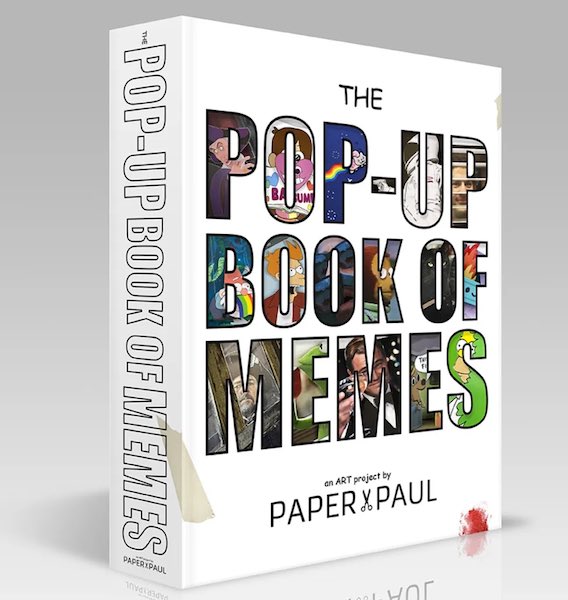
Only Dumpster Fire card and This Is Fine card are available for purchase.
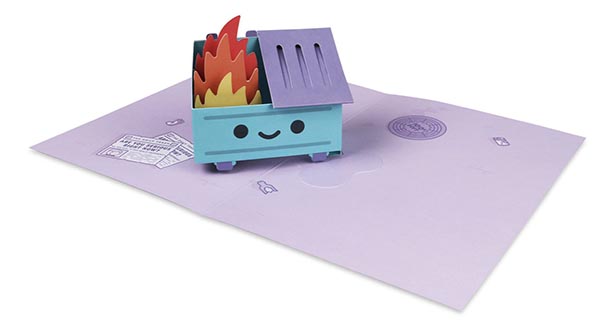
Check out what he’s been working on:
Downhill Skiing
Exuberant ski jumps executed on a snowless terrain in the shadow of a nuclear power plant bum me out.
— Bradley Whitford (@BradleyWhitford) February 8, 2022
Another DLE
Maybe we can consider them variants of Wordle. Anyway, two weeks ago, we mentioned Lewdle and Sweardle, and now this week we have another Wordle-like game, this time based on mathematical equations. Check out Nerdle.
Oh, and it looks there are even more:
Worldle, another Wordle style game with countries, but this time guessing by shape.https://t.co/cHkrNzVA58 pic.twitter.com/LyEsxR3Ake
— OnlMaps (@onlmaps) February 7, 2022
Dickensdle
This week at The Guardian, something better than Wordle (or even The Da Vinci Code): “The Dickens Code.” The what?
Charles Dickens was a notoriously messy writer. His manuscripts are full of inky splodges, with barely legible alterations crammed in between scrawled, sloping lines. Worse still was his love of a type of shorthand dating from the 1700s. To this, he added his own chaotic modifications to create what he called “the devil’s handwriting”.
Fond of puzzles and codes, the great Victorian writer used these time-saving hieroglyphics to make notes and copies of his letters and documents, reams of which he burned. Academics are still toiling to decipher 10 shorthand manuscripts that survived. Forget Wordle. This is the Dickens Code. And for a long time, it had seemed uncrackable.
Experts behind what is known as the Dickens Code project launched a competition: decipher a mystery letter that Dickens wrote using his code.
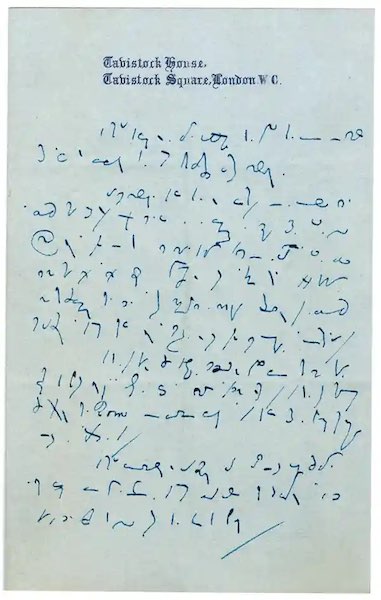
When the competition opened last October with a £300 prize, the note was downloaded 1,000 times in three days. Participants were invited to use guides to brachygraphy, the now obsolete shorthand system that Dickens had adapted. In the semi-autobiographical David Copperfield, brachygraphy is described as a “savage stenographic mystery”.
Competitors also had access to a notebook in which Dickens explained, with characteristic ambiguity, some of his own symbols. He used “@” for “about” and an angular kind of “t” to mean “extraordinary”. In the end, only 16 people, from all over the world, were able to submit solutions. None managed the entire thing.
The Dickens Code folks managed to compile all the entries and believe they have deciphered 70% of it. What does it say?
Sadly, it is not notes for – or even part of – a long-lost short story, although there is hope that the other documents may include fiction. What it does reveal is a suitably convoluted tale of a canny businessman who has reached a fraught juncture in his love life and literary career, and is now leaning on his connections and the courts for help.
“The decoders really have helped to cast light on this troubled period in Dickens’s life,” says Dr Claire Wood, lecturer in Victorian literature at the University of Leicester.
The year the letter was written was 1859. His marriage had just broken up and he was in financial straits, and hoping to launch his own journal. The letter (and others written around the same time) are believed to be Dickens’ entreating help from friends and colleagues. Now with the code cracked, they can begin to look at his other encoded documents.
At the End of the Day
You couldn’t make The Godfather today. It’s almost midnight, and making films takes ages.
— Chris Hewitt (@ChrisHewitt) February 7, 2022
Brand Colors
We’re dubious about this scheme. From Boing Boing:
The Color Museum wants to monetize the building blocks of NFT avatars by licensing out the exclusive rights to specific hexadecimal colors on the Blockchain, which you can select and name yourself. I f***ing hate that sentence. By doing this, they claim, the owner of each color will somehow get paid a royalty every time that color is used in someone else's NFT avatar.
From the Color Museum, and, no, we make no claim to understanding any of it:
Own your color for eternity—or as long as Ethereum exists*. As a new primitive, the tokenID associated with your color resolves completely on-chain, now and forever.
We convert the hexadecimal associated with your color into pure number and use that for the NFT's tokenID, which is the primary immutable component of the ERC-721 specification. This makes it suitable for computation and—experimentation.
*And as long as you (and your heirs) exist. You can also trade your Color NFT on any open NFT marketplace that supports the ERC-721 standard, such as OpenSea.
And if you take cranberries and stew them like apple sauces it taste much more like prunes than rhubarb does.
As Boing Boing does its best to explain, if you take an NFT like, for some reason, Bored Ape Yacht Club #9245, it contains 398,151 pixels. If you break down each pixel by hexadecimal color, 65.47% of that image is #E4E4A8, 4.71% is #6C6F5F, and so on. If you then own the NFT of #E4E4A8, the Color Museum claims, you could make $5,738.54 the next time that NFT avatar sells. “This calculation is based on a 1.25% fee, using the ‘current offer of 247.1 ETH for this ape.’” (Can we get the Dickens Code guys here, please?) Boing Boing did the math and found that the actual return would be more like nine cents. So, a bit less. Ultimately, they conclude, “either I’m missing something, or privatizing colors is a stupid scam.” They add, “who wants to invest in my new NFT platform to privatize letters of the alphabet?” Don’t give them any ideas!
English Exam for the Day
Writing Puzzle #7.
— Merriam-Webster (@MerriamWebster) January 27, 2022
Can you translate this into plain English, and get it under ten words?
“Going forward, we want to leverage our core competencies and at the end of the day gather key learnings about why our marine vessel failed to remain in a buoyant capacity.”
Where the Rubber Meets the Graphene
Was it a good week for graphene news? It’s always a good week for graphene news! Sweden-based 2D fab is working with green-technology company EcoRub to develop graphene-enhanced recycled rubber and other polymers. From Graphene-Info:
graphene will be used in recycled rubber materials to improve its properties, reportedly aiming to create new business opportunities and enable use in new products. In addition, the need for virgin fossil-based rubber should decrease as resources are utilized in a more sustainable way.
Ice Ice Baby
Why is the theme of couples figure skating always “we are in love and this is our passion in dance form”. Why couldn’t it be “we just robbed a bank together and this is how we are escaping! But we’re just friends.”
— Lucy Huber (@clhubes) February 7, 2022
Plastic Meets Steel
From Channel 7 News in Boston:
Scientists at the Massachusetts Institute of Technology have created a new material that combines the strength of steel and the lightness of plastic.
Doctor Michael Strano, a professor of chemical engineering at MIT and the lead author of this study, said the new material is even harder to break than bulletproof glass.
Dr. Strano says the material is chemically close to Kevlar, and indeed they make bulletproof vests out of it.
Researchers say this new material could be used to make everything from lightweight coatings for cars and phones to important infrastructure such as bridges.
Uh, oh…could something be muscling in on graphene’s territory? Don’t get graphene mad. You wouldn’t like graphene when it’s mad.
Taking the Biscuit
Is there science to this or is it literally that you are unconscious for another hour and thus unable to eat biscuits pic.twitter.com/rZOYDGl6s2
— Mollie Goodfellow (@hansmollman) February 7, 2022
A Toast to the Toaster
Did you know that the toaster dates back more than 200 years, even before the advent of electricity? Well, you do now. Celine Deprez is an Industrial Design student at France’s ENSCI (French National Institute for Advanced Studies in Industrial Design), and via Core77, went “in search of an object that represents [a] short lifespan while responding to a need that remains unchanged over time.” In other words, what kinds of products have a relatively short lifespan but are still in very high demand? She came up with the toaster, which, in France at least, is used every day but has a life span of only 2–3 years, and is only thrown out when it breaks. While one solution would be to develop a toaster that breaks less often, she went in a different direction, and one that the toasters of yesteryear went: a toaster that used heat from a cooktop to toast bread.
the most rudimentary and robust model is the one made of a single piece of aluminum foundry, with an enamel finish to make it food safe and easily cleanable. The enamel allows me a choice of color, red which is part of the food universe.
Deprez’s project, the Fourche à pain, won the Low-Tech Prize in the Aluminnov design competition, sponsored by France’s aluminum industry. Said the jury:
Robust, practical and inexpensive, it is placed directly on the heat sources available in the kitchen. The body, made of enamelled aluminum casting, provides conductivity thermal and evenly distributes the heat over the whole object. Stainless steel handles are on each side, allowing it to be moved at any time and in complete safety. Functional and stylish, Fourche à pain is a relevant response to the planned obsolescence of household appliances. The jury particularly praised the elegance of the form and the designer's research work on warmth."
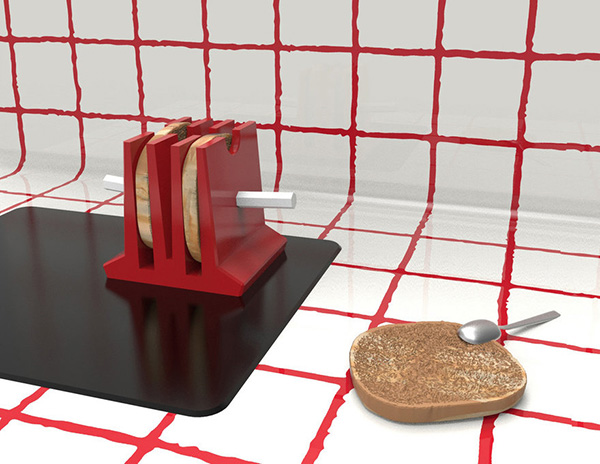
Love Snack
(Fred Schneider voice) pic.twitter.com/BGf0juKgqQ
— blaine capatch (@blainecapatch) February 8, 2022
Meteor Tomatoes
We’ve all heard the question, “Why is the sky blue?” (Short answer: Raleigh scattering.) But a recent episode of The Unbelievable Truth inspired us to pose a related question: why are tomatoes red? It turns out that the meteor collision that led to the extinction of the dinosaurs may also have caused tomatoes to turn red. No, really. According to a genome sequencing project undertaken by the (no, really) Tomato Genomics Consortium, summed up in an article in Nature and reported by Phys.org, the genome of the original tomato plant tripled in size at around the time of the meteor collision.
“Such a big genome expansion points to extremely stressful conditions,” says René Klein Lankhorst, the Wageningen UR coordinator of the tomato genome research project. “We suspect that the meteorite crash and the resulting solar eclipse had created conditions difficult for plants to survive. A distant ancestor of the tomato plant then reacted by expanding its genome considerably in order to increase its chances of survival.”
When conditions subsequently improved again, this ancestor of the tomato got rid of a lot of genetic ballast, but the genetic base for fruit formation had already been developed by then, the tomato fruit acquired its red colour and certain genes which produced toxins disappeared, says Klein Lankhorst. In this way, the tomato differentiates itself from a family member, the potato, which has no edible fruits.
All Maps Amazing Brilliant and Terrible, Part the Infinity
Oldest companies in Europe - https://t.co/BFGvkFEmaW pic.twitter.com/KPCP9Giqey
— Brilliant Maps (@BrilliantMaps) February 6, 2022
— Terrible Maps (@TerribleMaps) February 7, 2022
Whiteout Conditions
Forget the Olympics, we know you have been on the edge of your seats awaiting the results of this year’s second annual Minnesota Department of Transportation Name a Snowplow contest. Launched last year, one of the first winners was Plowy McPlowFace (why does anything think this is a good idea?). The contest asked Minnesota residents to name eight snowplows, representing each of MnDOT’s eight districts. This year’s winners were pretty clever, actually:
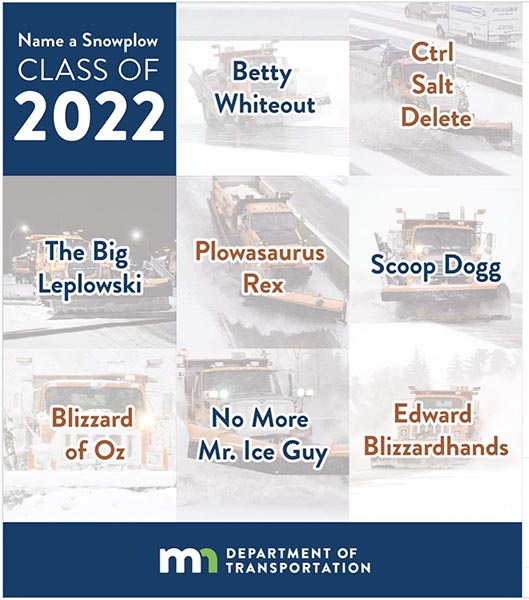
We do appreciate the tribute to the late, great Betty White.
Still…
I homeschooled my kids and they turned out amazing. They're smart, athletic, and well-adjusted. No drugs, alcohol, shootings, or pre-marital sex, and they're able to think for themselves rather than simply being programmed. Yes, they are cats but still.
— Molly Hodgdon (@Manglewood) December 16, 2021
The Feathers Will Fly
Put down any coffee or other beverage you may be drinking. This Guardian headline caught us off-guard: “Pillow fighting could be the next great combat sport.” We warned you. Enter a new organization called the Pillow Fight Championship (PFC) founded in South Florida by Steve Williams. “There’s just something so cathartic about getting hit in the head with a pillow,” he said. Is there? His goal, then, is to turn pillow fighting into a professional sport, and he has already staged a match. “The match took place back in October, but tonight it’s available for the first time, free of charge, on Fite.tv, the premier direct-to-consumer streaming service for combat sports.”
In one week he will host the PFC Pound Down in Miami, his company’s largest organized pillow fight and the first pay-per-view event, where the sport’s inaugural champions will be crowned. A willing audience would be a boon for his cause.
The pillows – which make a crinkling sound like a dry diaper when held still and crack like a horsewhip when connecting with a cheekbone – are queen-sized, stuffed with foam and encased in nylon sailcloth. Fighters are matched up according to relative size and experience levels by what’s called a “matchmaker” in the universe of combat sports. There are only three 90-second rounds because hurling a broad, 2lb pillow with the torque of a golf club becomes virtually impossible after the four-minute mark, even for athletes in elite shape.
We think the official uniforms for pillow fighters should be footie pajamas.
Super Calendaring
Morning! pic.twitter.com/sA9SHodek4
— Jerry Ewing (@TheJerryEwing) February 8, 2022
L’EGO My Sushi
From Laughing Squid:
Animator I Like Home has created a LEGO stop motion video that shows the process of turning an entire king salmon fish into sushi. The chef scaled and deboned the LEGO fish before slicing it into bite-sized blocks. He then turned to the accouterments, adding onion, rice, wasabi, and soy sauce for a nice sushi meal.
Text Alert
‘Information About Your Upcoming Flight’ Email Informs Passenger That Airplane Will Go In Sky https://t.co/4TurIf9Vaf pic.twitter.com/FRlSkpelIB
— The Onion (@TheOnion) December 3, 2021
This Week in Printing, Publishing, and Media History
February 7
1497: In Florence, Italy, supporters of Girolamo Savonarola burn cosmetics, art, and books, in a “Bonfire of the vanities.”
1812: English novelist and critic Charles Dickens born.
1885: American novelist, short-story writer, playwright, and Nobel Prize laureate Sinclair Lewis born.
1898: Émile Zola is brought to trial for libel for publishing J'Accuse…!.
1997: NeXT merges with Apple Computer, starting the path to Mac OS X.
February 8
1587: The death of Mary, Queen of Scots (b. 1542).
1828: French author, poet, and playwright Jules Verne born.
1834: Russian chemist and academic, and creator of the Periodic Table of Elements Dmitri Mendeleev born.
1915: D. W. Griffith’s controversial film The Birth of a Nation premieres in Los Angeles.
1922: United States President Warren G. Harding introduces the first radio set in the White House.
1946: The first portion of the Revised Standard Version of the Bible, the first serious challenge to the popularity of the Authorized King James Version, is published.
1971: The NASDAQ stock market index opens for the first time.
1978: Proceedings of the United States Senate are broadcast on radio for the first time.
February 9
1737: English-American philosopher, author, activist, and pamphleteer Thomas Paine born.
1870: US president Ulysses S. Grant signs a joint resolution of Congress establishing the U.S. Weather Bureau.
1881: Russian novelist, short story writer, essayist, and philosopher Fyodor Dostoyevsky dies (b. 1821).
1923: Irish rebel, poet, and playwright Brendan Behan born.
1964: The Beatles make their first appearance on The Ed Sullivan Show, performing before a record audience of 73 million viewers across the US.
1986: Halley’s Comet last appeared in the inner Solar System.
February 10
1890: Russian poet, novelist, literary translator, and Nobel Prize laureate Boris Pasternak born.
1898: German director, playwright, and poet Bertolt Brecht born.
1940: Tom and Jerry make their debut with the cartoon Puss Gets the Boot.
1962: Roy Lichtenstein’s first solo exhibition opens. It includes Look Mickey, which featured his first use of Ben-Day dots, speech balloons, and comic imagery sourcing, all of which he is now known for.
1967: American director, producer, and screenwriter Vince Gilligan born.
1996: IBM supercomputer Deep Blue defeats Garry Kasparov in chess for the first time.
2005: American actor, playwright, and author Arthur Miller dies (b. 1915).
February 11
1650: French mathematician and philosopher René Descartes dies (b. 1596). Guess he didn’t think.
1800: English photographer, politician, and inventor of the calotype Henry Fox Talbot born.
1840: Gaetano Donizetti’s opera La fille du régiment receives its first performance in Paris, France.
1843: Giuseppe Verdi’s opera I Lombardi alla prima crociata receives its first performance in Milan, Italy.
1847: Thomas Edison born.
1909: American director, producer, and screenwriter Joseph L. Mankiewicz born.
1938: BBC Television produces the world’s first ever science fiction television program, an adaptation of a section of the Karel ?apek play R.U.R., that coined the term “robot.”
February 12
1804: German anthropologist, philosopher, and academic Immanuel Kant dies (b. 1724).
1809: English geologist and theorist Charles Darwin born.
1809: Sixteenth U.S. President Abraham Lincoln born.
1885: German publisher and founder of Der Stürmer Julius Streicher born.
1924: George Gershwin’s Rhapsody in Blue receives its premiere in a concert titled “An Experiment in Modern Music,” in Aeolian Hall, New York, by Paul Whiteman and his band, with Gershwin playing the piano.
1948: American computer scientist and engineer Ray Kurzweil born.
1950: English singer-songwriter, guitarist, and producer Steve Hackett born.
1994: Four thieves break into the National Gallery of Norway and steal Edvard Munch’s iconic painting The Scream.
February 13
1914: In New York City, the American Society of Composers, Authors and Publishers is established to protect the copyrighted musical compositions of its members.
1923: American general and pilot, and first test pilot to break the sound barrier Chuck Yeager born.
Buzz saying Happy Birthday to Chuck Yeager is why god made Twitter. https://t.co/fgzL9Ct4Lh
— Charles P. Pierce (@CharlesPPierce) February 14, 2019
1950: English singer-songwriter and musician Peter Gabriel born. Here comes the flood.
1967: American researchers discover the Madrid Codices by Leonardo da Vinci in the National Library of Spain.










Discussion
Join the discussion Sign In or Become a Member, doing so is simple and free